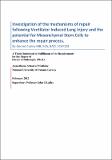| dc.description.abstract | Introduction: ARDS is a syndrome of acute respiratory failure that presents with progressive arterial hypoxemia, dyspnea, and a marked increase in the work of breathing. Virtually all patients with ARDS receive mechanical ventilation. However, the delivery of even 'normal' tidal volumes may indeed have the potential to be quite injurious to the injured, mechanically ventilated ARDS lung. Lung ventilation volume increases lead to progressive epithelial cell deformation, with disruption of the alveolar-capillary barrier and injury to the alveolar epithelium. One of the most important mechanisms that determines the severity of lung injury is the magnitude of injury to the alveolar epithelial barrier. The possibility of repairing the epithelial injury at an early stage is a major determinant of recovery. Specific treatments to accelerate alveolar epithelial repair do not exist. Little is known at present about the cellular and molecular mechanisms of of efficient and aberrant alveolar epithelial repair in ALI/ARDS. Recent pre-clinical experimental studies indicate that bone-marrow derived mesenchymal stem cells (MSCs) may reduce the severity of Acute Lung Injury (ALI). However the potential for MSC's to enhance repair and recovery following ALI is not known.
Methods: We first described the factors important in the development of an animal model of recovery from VILI, allowing the study of the development and repair from this type of lung injury over time. We then sought to examine the pattern of inflammation, injury, and repair, the time course and mechanisms of resolution and repair, and the potential for fibrosis, following ventilation induced lung injury (VILI). We then used our unique animal model of repair from VILI to test the reparative properties of MSCs, using different doses and timing of delivery. We also examined the potential for non-stem cells, and for MSC secreted products, to enhance repair in comparison to MSCs. The contribution of specific MSC secreted mediators was then examined in a wound healing model.
Finally we examined different routes of administration of MSCs in our repair model.
Results: We defined factors that are important in the development of VILI and integral to developing a reliable, reproducible animal model that represents the disease, including younger animal age, peak pressures above a threshold value and higher inspiratory flow rates. We developed a cohort of animals with an homogenous injury, that was representative of stretch induced lung damage. High stretch ventilation caused a severe lung injury, activating a transient inflammatory and fibroproliferative repair response, which restored normal lung architecture without evidence of fibrosis. MSCs therapy enhanced repair following VILI. Specifically, MSCs improved oxygenation, lung compliance, reduced total lung water, decreased lung inflammation and histologic lung injury. MSC therapy attenuated alveolar TNF-alpha and IL-6 levels, but increased alveolar IL-10 concentrations. Conditioned MSC medium also enhanced lung repair and attenuated the inflammatory response to lung stretch. MSCs and their conditioned medium were twice as effective in healing alveolar epithelial wounds in comparison to fibroblasts and their conditioned medium controls. Antibodies to Keratinocyte Growth Factor, but not Hepatocyte Growth Factor, or Transforming Growth Factor-¿, attenuated this effect on alveolar epithelial repair of MSC conditioned medium. Finally, intratracheal MSC therapy and intra-tracheal conditioned MSC medium also enhanced lung repair and attenuated the inflammatory response to lung stretch.
Conclusion: This novel rat model of repair from VILI will serve to improve our knowledge of the mechanisms of repair as well as provide a useful paradigm for testing strategies to hasten recovery in ALI. In our studies of repair from VILI, multiple targets to hasten recovery were identified, and the potential for a more sustained fibroproliferative response was noted. MSCs, delivered systemically or locally, can modulate the inflammatory response to VILI, enhance alveolar fluid clearance and augment repair in the lung. The therapeutic effect appears to be mediated through paracrine factors secreted by MSCs. The ability of MSCs to enhance recovery after Ventilator Induced Lung Injury may in part be due to their abiltiy to enhance alveolar epithelial wound repair, and that this mechansim may result wholly or in part from the secretion of Keratinocyte Growth Factor by MSCs. | en_US |


